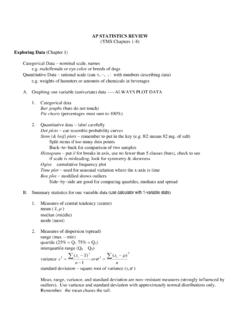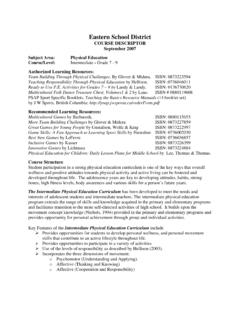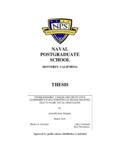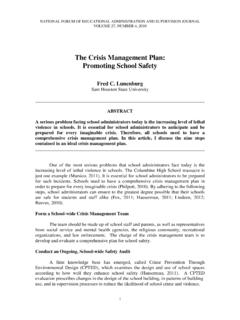Transcription of A general inductive approach for qualitative data analysis
1 A general inductive approach for qualitative data analysis David R. Thomas school of Population Health University of Auckland, New Zealand Phone +64-9-3737599 Ext 85657 email August 2003 An outline of a general inductive approach for qualitative data analysis is described and details provided about the assumptions and procedures used. The purposes for using an inductive approach are to (1) to condense extensive and varied raw text data into a brief, summary format; (2) to establish clear links between the research objectives and the summary findings derived from the raw data and (3) to develop of model or theory about the underlying structure of experiences or processes which are evident in the raw data . The inductive approach reflects frequently reported patterns used in qualitative data analysis . Most inductive studies report a model that has between three and eight main categories in the findings.
2 The general inductive approach provides a convenient and efficient way of analysing qualitative data for many research purposes. The outcomes of analysis may be indistinguishable from those derived from a grounded theory approach . Many researchers are likely to find using a general inductive approach more straightforward than some of the other traditional approaches to qualitative data analysis . A general inductive approach for qualitative data analysis David R. Thomas, school of Population Health, University of Auckland, August 2003 2 A general inductive approach for qualitative data analysis There is a wide range of literature that documents the underlying assumptions and procedures associated with analysing qualitative data . Many of these are associated with specific approaches or traditions such as grounded theory (Strauss & Corbin, 1990), phenomenology ( , van Manen, 1990), discourse analysis ( , Potter & Wetherall, 1994) and narrative analysis ( , Leiblich, 1998).
3 However some analytic approaches are generic and are not labelled within one of the specific traditions of qualitative research ( , Ezzy, 2002; Pope, Ziebland, & Mays, 2000; Silverman, 2000). In working with researchers who adopt what has been described as a critical realist epistemology (Miles & Huberman, 1994) the author has found that many researchers unfamiliar with any of the traditional approaches to qualitative analysis , wish to have a straightforward set of procedures to follow without having to learn the technical language or jargon associated with many of the traditional approaches. Often they find existing literature on qualitative data analysis too technical to understand and use. The present paper has evolved from the need to provide researchers analysing qualitative data with a brief, non-technical set of data analysis procedures. A considerable number of authors reporting analyses of qualitative data in journal articles (where space for methodological detail is often restricted) describe a strategy that can be labelled as a general inductive approach .
4 This strategy is evident in much qualitative data analysis (Bryman & Burgess, 1994; Dey, 1993), often without an explicit label being given to the analysis strategy. The purpose of the present paper is to describe the key features evident in the general inductive approach and outline a set of procedures that can be used for the analysis of qualitative data . The inductive approach is a systematic procedure for analysing qualitative data where the analysis is guided by specific objectives. The primary purpose of the inductive approach is to allow research findings to emerge from the frequent, dominant or significant themes inherent in raw data , without the restraints imposed by structured methodologies. Key themes are often obscured, reframed or left invisible because of the preconceptions in the data collection and data analysis procedures imposed by deductive data analysis such as those used in experimental and hypothesis testing research.
5 The following are some of the purposes underlying the development of the general inductive approach . These purposes are similar to other qualitative analysis approaches. 1. To condense extensive and varied raw text data into a brief, summary format. 2. To establish clear links between the research objectives and the summary findings derived from the raw data and to ensure these links are both transparent (able to be demonstrated to others) and defensible (justifiable given the objectives of the research). 3. To develop of model or theory about the underlying structure of experiences or processes which are evident in the text (raw data ). The general inductive approach is frequently reported in health and social science research. The following examples of descriptions, taken from the methods sections of A general inductive approach for qualitative data analysis David R. Thomas, school of Population Health, University of Auckland, August 2003 3 research reports, illustrate data analysis strategies that have used a general inductive approach .
6 The transcripts were read several times to identify themes and categories .. In particular, all the transcripts were read by AJ and a subsample was read by JO. After discussion a coding frame was developed and the transcripts coded by AJ. If new codes emerged the coding frame was changed and the transcripts were reread according to the new structure. This process was used to develop categories, which were then conceptualised into broad themes after further discussion. The themes were categorised into three stages: initial impact, conflict, and resolution. (Jain & Ogden, 1999, p. 1597) Emerging themes (or categories) were developed by studying the transcripts repeatedly and considering possible meanings and how these fitted with developing themes. Diagrams were used to focus on what was emerging and to link patient and doctor themes into major barriers to referral. Transcripts were also read horizontally , which involved grouping segments of text by theme.
7 Towards the end of the study no new themes emerged, which suggested that major themes had been identified. (Marshall, 1999, p. 419) A rigorous and systematic reading and coding of the transcripts allowed major themes to emerge. Segments of interview text were coded enabling an analysis of interview segments on a particular theme, the documentation of relationships between themes and the identification of themes important to participants. Similarities and differences across sub-groups ( service providers vs individuals, recent vs long-term migrants) were also explored. (Elliott & Gillie, 1998, p. 331) The inductive approach is evident in several types of qualitative data analyses, especially grounded theory (Strauss & Corbin, 1990). It is very similar to the general pattern of qualitative data analysis described by others ( , Miles & Huberman, 1994, p. 9; Pope et al, 2000). inductive approaches are intended to aid an understanding of meaning in complex data through the development of summary themes or categories from the raw data ( data reduction ).
8 These approaches are evident in many qualitative data analyses. Some have described their approach explicitly as inductive ( , Backett & Davison, 1995; Stolee, Zaza, Pedlar, & Myers, 1999) while others use the approach without giving it an explicit label ( , Jain & Ogden, 1999; Marshall, 1999) Underlying assumptions Some of the assumptions, which can be seen as underlying the use of a general inductive approach , are described below. 1. data analysis is determined by both the research objectives (deductive) and multiple readings and interpretations of the raw data ( inductive ). Thus the findings are derived from both the research objectives outlined by the researcher(s) and findings arising directly from the analysis of the raw data . 2. The primary mode of analysis is the development of categories from the raw data into a model or framework that captures key themes and processes judged to be important by the researcher.
9 A general inductive approach for qualitative data analysis David R. Thomas, school of Population Health, University of Auckland, August 2003 4 3. The research findings result from multiple interpretations made from the raw data by the researchers who code the data . Inevitably, the findings are shaped by the assumptions and experiences of the researchers conducting the research and carrying out the data analyses. In order for the findings to be usable, the researcher ( data analyst) must make decisions about what is more important and less important in the data . 4. Different researchers are likely to produce findings which are not identical and which have non-overlapping components. 5. The trustworthiness of findings can be assessed by a range of techniques such as (a) independent replication of the research, (b) comparison with findings from previous research, (c) triangulation within a project, (d) feedback from participants in the research, and (e) feedback from users of the research findings.
10 Features of categories developed from coding The outcome from an inductive analysis is the development of categories into a model or framework that summarises the raw data and conveys key themes and processes. The categories resulting from the coding, which are the core of inductive analysis , potentially have five key features. 1. Label for category: Word or short phrase used to refer to category. The label often carries inherent meanings that may not reflect the specific features of the category. 2. Description of category: Description of the meaning of category including key characteristics, scope and limitations. 3. Text or data associated with category: Examples of text coded into category that illustrate meanings, associations and perspectives associated with the category 4. Links: Each category may have links or relationships with other categories. In a hierarchical category system ( , tree diagram) these links may indicate superordinate, parallel and subordinate categories ( , parent, sibling or child relationships).







